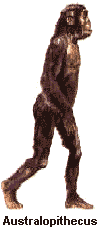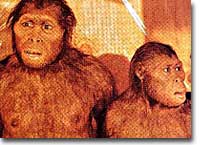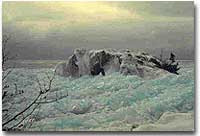
2. Prehistoric Times
What did the earth look like four million years ago? Who lived here? What did they look like?Humans are curious creatures. We want to know where we came from, in part, as a way of figuring out where we are going in the future.
Our need to know is sometimes overwhelming. Archaeologists and anthropologists dig through dirt, study DNA samples, examine artifacts, and try to construct a picture of the earliest human ancestors.

Archaeologists study the physical evolution of man as well as the development of the human condition over the ages.
Artifacts, by the way, are not facts about art. Rather, artifacts are things created by humans (tools, vases, clothing) for practical purposes.
Can You Dig It?
Digging into our ancestors' past is hard work. Records of human life were not kept millions of years ago. What was life like for cavepeople in the Stone Age? Did Fred Flintstone actually wear leopard skin suits and eat brontosaurus burgers?
Evidence of life from about 30,000 years ago has been found in cave paintings, in burial chambers, and in the form of crude tools. But what about time dating earlier than that? This "Prehistoric" period — before writing and civilizations — is called the Stone Age and is extremely valuable to our understanding of our earliest hominid ancestors. Hominids comprise humans today, extinct ancestors, and apes that share similarities with humans.
The earliest and longest period of the Stone Age is called the Paleolithic Age. This comes from the Greek word Palaios, meaning "long ago" or "old," and lithos, meaning "stone" — put together, Paleolithic Age means Old Stone Age.

This may have been what early human ancestors looked like over three million years ago.
The Old Stone Age began approximately 4.5 million years ago. It lasted until about 25 thousand years ago — relatively recently in terms of the overall age of the earth. It was at the beginning of the Old Stone Age, approximately 4.4 million years ago, that the first human ancestors made their appearance on earth.
Approximately 3.5 million years ago, hominids began walking upright. What did they eat? Where did they live? The archaeological evidence is not clear. Those who study the earliest hominids do know, however, that these human ancestors physically changed in response to their environment.
Chill Out
Dramatic changes in world climate started taking place about 1.5 million years ago. Most of the world became cold — really cold. This plunge in temperature began one of four distinct periods of frigid temperatures known as an Ice Age. Each of these frigid periods lasted from 10,000 to 50,000 years. The most recent chilled the Earth just over 10,000 years ago.

During this most recent Ice Age, the northern polar icecap moved so far south that massive sheets of ice were created over much of the northern hemisphere. In some areas the ice was several miles thick. About 1/3 of the earth's surface was encased in an icy layer — that's four times the amount of ice normally found on earth today. Naturally, hunting and gathering abilities were interfered with during the Ice Ages.
Once these frigid years were over, a revolution took place — humans started planting crops. This new way of life, which began about 10,000 years ago, led to permanent settlements and the world's first communities. Farming and the domestication of animals mark the beginning of the Neolithic Age, also called the New Stone Age.
So what then did Fred Flintstone wear and eat? What follows is a look at some of our earliest known human ancestors — how they lived, how they changed, and how they interacted with their environment.
Archeologists and anthropologists "meet the Flintstones" every time they unearth the remains of prehistoric people. Their work helps to answer profound questions:
- Who are humans?
- Where did we come from?
- Where are we going?
| Years ago | Epoch (Geological) |
Hominid Species | Famous Finds | Cultural stage | Cultural flashpoints |
|---|---|---|---|---|---|
| 4.4 million | end of Pliocene | Ardipithecus | remains found by Tim White, etc. | Paleolithic (Old Stone Age) |
pebble tools, hand axes, choppers |
| 3.2 million | Australopithecus | Lucy | |||
| 1.8 million | Australopithecus | Zinjanthropus Man | |||
| 1.6 million | Homo Habilis | Cindy | |||
| 1 million | Pleistocene (Ice Age) (Glacial Epoch) |
||||
| 700,000 | Homo Erectus | Pithecanthropus (Java Man) |
|||
| 500,000 | Homo Erectus Homo Erectus |
Heidelberg Beijing Man |
fire | ||
| 200,000 | Homo Sapiens | Rhodesian Man | flake tools | ||
| 60,000 | Homo Sapiens | Neanderthal Man | buried their dead | ||
| 50,000 | Homo Sapiens | Old Man | cave paintings, sewing, spears | ||
| 25,000 | Homo Sapiens | Cro-Magnon | |||
| 10,000 | Holocene | all modern people | Mesolithic (Middle Stone Age) |
use of animals, farming, bows and arrows, harpoons, canoes | |
| 8,000 | Neolithic (New Stone Age) |
villages, saws, drills, pottery, weaving, plow | |||
| 5,000 | Bronze Age | wheels, cities, writing | |||
| 3,000 | Iron Age | use of iron, alphabets, empires | |||






